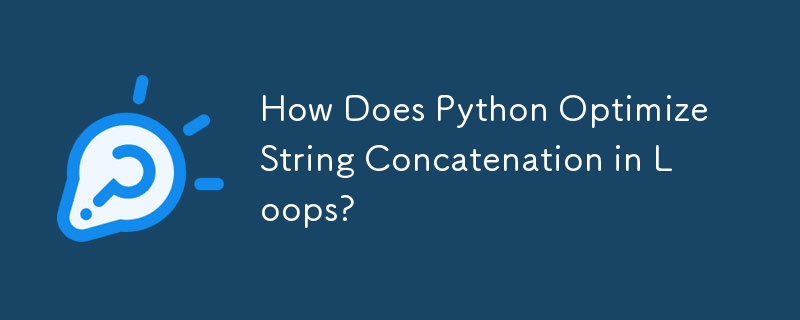

Concatenating Strings in Python: Achieving Efficiency
In Python, appending one string to another has traditionally been accomplished through assignment:
var1 = "foo" var2 = "bar" var3 = var1 + var2
While this approach is straightforward, it can become inefficient when concatenating multiple strings, especially in a loop. To address this, CPython has introduced an optimization to enhance performance in such scenarios.
CPython's String Concatenation Optimization
CPython's optimization involves an in-place extension of the string. When a string is concatenated to the end of another string referenced by only one variable, the interpreter attempts to extend the original string instead of creating a new object. This operation is amortized O(n), meaning that the time complexity for appending multiple strings in a loop is significantly reduced.
For example, the following code:
s = ""
for i in range(n):
s += str(i)which used to have a time complexity of O(n^2), now runs at O(n).
Impact of Optimization
This optimization has a substantial impact on performance, especially for string concatenation in loops. Empirical testing demonstrates that appending one million strings now takes only 173 milliseconds, compared to 14.6 seconds using the old O(n^2) approach.
Limitations
It's important to note that this optimization is specific to CPython and may not apply to other Python implementations like PyPy or Jython. Additionally, it only applies when a string is referenced by a single variable. If there are multiple references, the original string object will not be extended, and the performance benefits will be lost.
The above is the detailed content of How Does Python Optimize String Concatenation in Loops?. For more information, please follow other related articles on the PHP Chinese website!
 How to flash Xiaomi phone
How to flash Xiaomi phone
 How to center div in css
How to center div in css
 How to open rar file
How to open rar file
 Methods for reading and writing java dbf files
Methods for reading and writing java dbf files
 How to solve the problem that the msxml6.dll file is missing
How to solve the problem that the msxml6.dll file is missing
 Commonly used permutation and combination formulas
Commonly used permutation and combination formulas
 Virtual mobile phone number to receive verification code
Virtual mobile phone number to receive verification code
 dynamic photo album
dynamic photo album




